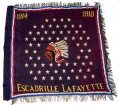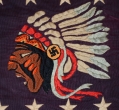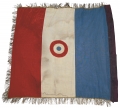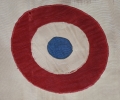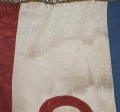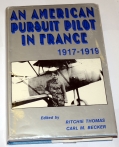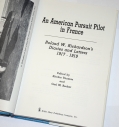site search
online catalog
LAFAYETTE ESCADRILLE VETERANS’ FLAG PRESERVED BY AN AMERICAN FLYER

$3,750.00 SOLD
Quantity Available: None
Item Code: 161-10
Probably no American fighting force in World War One is better known than the Lafayette Escadrille, a small group of some 38 American and 4 French flyers who, before America’s official entry in the war, fought as a unit under the French from April 1916 to February 1918. This is a banner of their veterans’ group, bearing the embroidered Lafayette Escadrille Sioux Indian head insignia surrounded by stars in the center, with the beginning and end dates of the war, 1914 and 1918, embroidered at top and the unit designation “ESCADRILLE LAFAYETTE” embroidered at bottom. The background is purple, oxidizing slightly toward brown. The reverse of the flag is the French tricolor with the French red, white and blue air corps roundel at center. The flag measures about 36 inches long and 32 inches high. It is bordered on three sides with a gold fringe and a sleeve the same color as the body of the flag on the hoist. A red, white and blue ribbon seems to have been added later as a border for the front of the flag, but another of these banners preserved in the National Museum of the U.S. Air Force has the same ribbon border.
Reunions of American flyers in French service happened almost immediately after the war, and the first veterans’ organization seems to have been formally established as early as 1928 to dedicate a memorial in France to American flyers who lost their lives in the French service. World War One veteran reunions of all sorts hit their stride in America in the 1940s, and we expect the flag dates sometime between those two points in time.
The flag has come down through the family of Roland W. Richardson, a lieutenant in the 213th Pursuit Squadron, whose letters and diary have been published under the title, “An American Pursuit Pilot in France.” (We include a copy with the flag.) Richardson saw action in the later part of 1918 and is often quoted on the problems and dangers of flying during that part of the war, particularly in regard to the miserable weather conditions for flyers in the lead up to the Meuse-Argonne offensive. Richardson records strafing enemy troops, taking enemy ground fire, and was given partial credit in the downing of a German aircraft.
Significantly, Richardson was not part of the Lafayette Escadrille. He was, however, part of the 3rd Pursuit Squadron, which also included the 103rd Pursuit Squadron, the American unit that absorbed old members of the Lafayette Escadrille after the U.S. entry into the war. Richardson lived to the age of 94, dying in 1991, and he seems to have become the custodian of a number of relics, many of which he donated to the Wright Patterson Museum in Dayton, Ohio. These included not only a Lewis gun, but an Indian head insignia from one of his planes. His family, however, retained this banner and we are proud to offer it. It represents a selfless defense of democracy even before the population as a whole rallied to the defense of the Allies. The condition is very good. The reverse has a little bit of soiling and water stain marks on the central white stripe of the tricolor flag. The face, however, is excellent. It displays wonderfully and could be the centerpiece of an impressive World War One air related display. (SR)
~~~~~~~~~~~~~~~~~~~~~~~~~~~~~~~~~~~~~
Roland Withenbury Richardson was born in Glendale, Ohio on March 22, 1897 the only son of James and Adelaide Richardson. The couple also had three daughters before James died of diphtheria in 1902. Despite the death of his father, Roland and his sisters and mother were well off having inherited James wealth and interest in the family paper business.
To provide her children with a “broad and cosmopolitan” education Adelaide moved her family to the French speaking town of Neuchatel, Switzerland in 1912. Here Roland attended school until 1914 when Adelaide decided to move the family to Germany, however, before she could make the move World War One erupted.
Returning to the United States Roland Richardson entered the University of Cincinnati in 1915. He was a sophomore when the United States declared war on Germany in April of 1917 and he immediately joined Battery E, 136th Field Artillery of the Ohio National Guard.
Discovering that he did not like horses, Roland’s Uncle, Col. Theodore Lyster, recommended him for a commission as 1st Lieutenant in the 29th Provisional Squadron. Roland was proficient in French and was assigned to the Squadron as an interpreter and sailed for France on July 17, 1917.
Upon arrival the 29th Squadron was assigned to the training air fields at Issoudun, France. During his stay here Richardson became acquainted with the future American ace Eddie Rickenbacker and Lt. Quentin Roosevelt, son of President Teddy Roosevelt, who was destined to be shot down and killed in July of 1918.
By September of 1917 Richardson found little to occupy him in Issoudun and applied to flight school. He was accepted and sent for basic flying instruction to the Second Aviation Training Center at Tours. He graduated in January of 1918 and was returned to Issoudun for secondary training.
Upon arrival at his new school Richardson was given the choice to train either as a bomber pilot, observation pilot or pursuit pilot. After some waffling, he chose pursuit pilot and began training in the French Nieuports.
Things progressed well for Richardson until his final test which involved engaging an instructor in a mock dogfight. For reasons never fully explained, other than to say he did not feel like dogfighting against that instructor, Richardson flew his plane in a straight line and did not engage in the battle. Upon landing the instructor washed Richardson out as a pursuit pilot and told him he would have to fly bombers.
Richardson proceeded to Orly near Paris where he test flew new aircraft. Besides the Nieuport he also got to fly in a Sopwith Camel and a Spad. During his time in Orly he made several flights taking Army photographers over Paris. Finally, in August of 1918 one of Richardson’s friends named Jack Ogden came to Orly to select pilots for the 213th Aero Squadron. Ogdon either ignored or was unaware of Richardson having been washed out as a pursuit pilot and chose him for duty with the 213th.
The 213th Pursuit Squadron was part of the 3rd Pursuit Group and was stationed near Toul at the town of Vaucouleurs near the tip of the St. Mihiel salient. The Group flew Spads and during Richardson’s first patrol over the front lines his Spad developed an oil leak and lost a magneto as he was landing. Despite being popular planes the Spad had its problems.
During the St. Mihiel offensive in September of 1918 Richardson flew many patrols against German ground targets such as troop and transportation targets. On September 14th Richardson and two other pilots attacked a German Fokker monoplane and shot it down. Each pilot received a third of a kill.
During the Muse-Argonne offensive Richardson flew many combat patrols as well as a few bombing escort missions. His Spad was shot up by anti-aircraft fire a few times but on each occasion Richardson landed okay.
After the Armistice Richardson returned home and was discharged from the Army in February of 1919. He returned to the family paper business where he remained for 35 years, married and raised a family. Also during that time, he was active in veteran’s organizations and was a founding member of the Order of Dedaelions which was a fraternity of commissioned military pilots.
Roland W. Richardson died in Cincinnati, Ohio at age 94 on July 16, 1991. [ad]
~~~~~~~~~~~~~~~~~~~~~~~~~~~~~~~~
THIS ITEM, AS WITH ALL OTHER ITEMS AVAILABLE ON OUR WEB SITE,
MAY BE PURCHASED THROUGH OUR LAYAWAY PROGRAM.
FOR OUR POLICIES AND TERMS,
CLICK ON ‘CONTACT US’ AT THE TOP OF ANY PAGE ON THE SITE,
THEN ON ‘LAYAWAY POLICY’.
THANK YOU!
Inquire About LAFAYETTE ESCADRILLE VETERANS’ FLAG PRESERVED BY AN AMERICAN FLYER
For inquiries, please email us at [email protected]
Most Popular
Historical Firearms Stolen From The National Civil War Museum In Harrisburg, Pa »
Theft From Gravesite Of Gen. John Reynolds »
Cavalry Carbine Sling Swivel »
Fine Condition Brass Infantry Bugle Insignia »
featured item
DAGUERROTYPE IN UNIFORM OF LEWIS HENRY LITTLE, BREVET FOR GALLANT AND MERITORIOUS CONDUCT AT MONTEREY 1846; KILLED IN ACTION AS CONFEDERATE BRIGADIER GENERAL AND DIVISION COMMANDER AT IUKA 1862
This very clear sixth-plate daguerreotype dates about 1850 and shows Lewis Henry Little, usually referred to by his middle name, as a Captain in the 7th U.S. Infantry. Born in Maryland in 1817, he was appointed 2nd Lieutenant in the 5th US Infantry… (1138-1808). Learn More »



